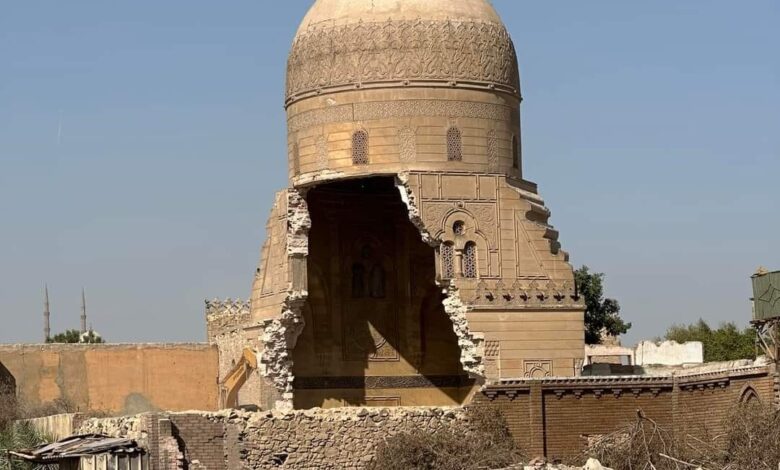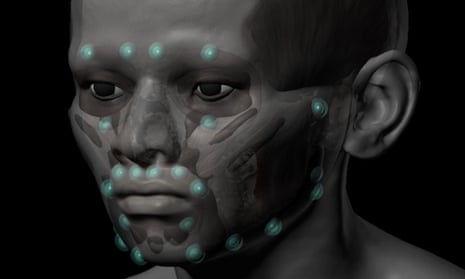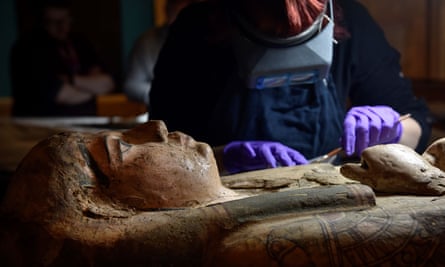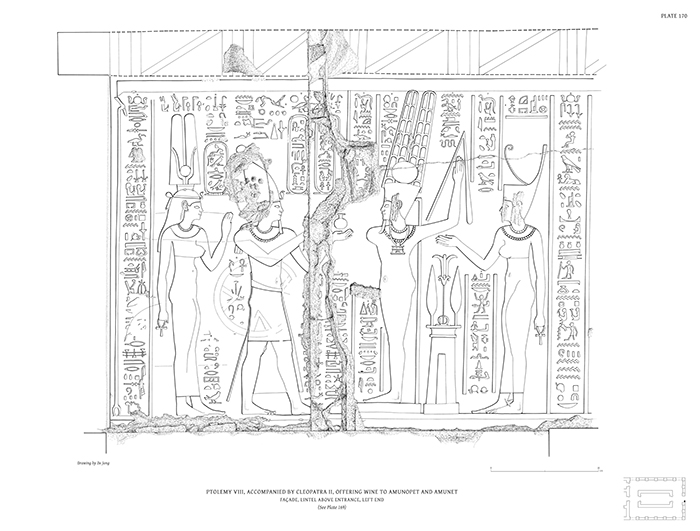A few miles south of Aswan, Egypt's bustling commercial gateway on the Nile, lies the Nubian village of Gharb Seheyl. Its colorful, low buildings stand out starkly against a backdrop of dusty desert hills and spill down to the grassy banks of the river. Each house is painted in bright colors and, although most are only a single story, they are fitted with huge, elaborately carved doorways.
When visitors are welcome, it is Nubian custom to leave the door ajar. Neighbors then know they can come as they please and sit in the inside courtyard for a while. These courtyards are the social heart of village life, where men and women sit in groups, chatting, doing light bits of work and preparing coffee on small gas stoves. Even the dead are invited to linger — small triangular holes are cut into the walls so that ancestors' souls have somewhere to rest. At least, that is what the Nubians, an ethnic group that has lived along the Nile in what is now southern Egypt and northern Sudan for thousands of years, believed before they converted to Islam. Now, it is mainly a decoration.
Zahra Adil's door is almost always open, and her blue-painted courtyard is busy with villagers. "Nubian culture is all about community," Adil says. The 38-year-old sits on a low stool in her courtyard, chatting with her mother in Nobiin. "We have a very strong culture, but our biggest challenge is preserving the language. That is very important for us — it stops us from disappearing."
She works hard to ensure that her children, aged 5, 10 and 12, learn to converse in their native tongue. For now, they understand Nobiin but seldom speak it. "They speak in Arabic because, at school, they learn in Arabic. Inshallah [God willing], when they are older, they will speak both languages."
Nobiin, the language Adil is trying to instill in her children, is the most widely spoken Nubian language, with about 900,000 speakers. Most of those consider their mother tongue to be an unwritten language. Yet centuries ago, the history, business, cultural and spiritual goings-on of the Nubian people were written down, using a unique alphabet and script that have since faded from use, though not memory.
Today, some of the young generation are attempting to revive that script through books, social media and apps. They believe their alphabet is an essential part of preserving Nubian heritage. It gives them access to their past; after all, history literally begins with writing. With an alphabet, a population has access to ancient texts and newly transcribed stories. They can protect cultural creations of the past and have a vessel for new ones.
It is widely acknowledged that the extinction of a language is a devastating cultural loss for ethnic minorities, but these Nubians raise a different question: What happens when an alphabet disappears? And is it possible — or even desirable — to save a script?
While the Nubians, Ancient Egypt's southern neighbors, first used hieroglyphs to write their language, they eventually derived their own script, known as Meroitic, which was used from the second century BCE. This consisted of 23 phonetic signs and existed in two versions, one simplified enough to be written with a stylus and the other made up of elaborate characters based on hieroglyphs for religious and monumental inscriptions. The British Egyptologist Francis L. Griffith began deciphering the Meroitic script in 1910 but it remains only partially decrypted, due to a lack of bilingual texts. While the Rosetta Stone provided a key for understanding Egyptian hieroglyphs through its Greek translation, no such equivalent has been found for Meroitic.
Meroitic faded out when Christian missionaries introduced the Coptic script, an alphabet almost entirely derived from Greek, in the 8th century. Nubian scribes adapted it to their own language, adding some letters borrowed from Meroitic to accommodate specific sounds. For reasons unknown, they also wrote all the letters slanted, making Old Nubian the only known alphabet in the world to be written entirely in italics.
Unlike many civilizations in the region, Nubia managed to resist the Arab conquest of the 7th century. Islamization happened both gradually and relatively peacefully, with administrative officials and settlers moving to the region and living alongside the Nubian population. Old Nubian was still in use until the 14th century, when the spread of Islam led Nubians to increasingly adopt the Arabic language and script.
It wasn't until the 20th century that the Nubian language was actively repressed. Both Egypt and Sudan sought to quash the language, intending to assimilate the minority into the predominantly Arab nations. It was banned in schools, and Nubian villages and landmarks were given Arabic names, erasing their history. Egyptian media long portrayed Nubians either as simple-minded fools for comic relief or in a flat "noble savage" way.
The Nubian alphabet's replacement by Arabic script is a classic example of how alphabets come to be marginalized, says Tim Brookes, the founder of the project The Atlas of Endangered Alphabets, and an advocate for preserving minority scripts. "When an alphabet is endangered, it tells us two things: that there has been an elaborate civilization, and it has come into contact with another group which has imposed its language."
"Restoring old scripts is an antidote to a colonial era mentality that suggests that one way of writing, one way of living, is superior to another," Brookes adds. He argues that minority scripts are important for various psychological and social reasons. One of the major ones is that "without a script, a people's history will always be written by somebody else."
"Once you have an alphabet, it is harder for people to write a history that ignores you," he argues.
This is especially important in the case of Nubia, whose millennia-long history of civilization, statehood and cultural output has long been sidelined by Western historians and archeologists, until recently studied only through the lens of Nubia's interactions with Ancient Egypt.
"Ancient Nubia was mistakenly seen as a derivative society in the shadow of its neighbor," explains Geoff Emberling, an archeologist specializing in the topic. He cites structural racism as the reason for this — there is less interest and less funding for research on Nubia compared to Ancient Greece or Egypt. A major reason for this is that Nubians are Black, Emberling has said. "People don't take the effort to look at this civilization," says Emberling. "And that is a mistake because it has such a rich history."
A rich history which is told to us in hieroglyphs, in Meroitic script, in Old Nubian. It is told through architectural marvels, such as the Meroe pyramids and the remains of Nubian settlements. It is also told through stories passed down through the generations in the courtyards of colorful houses by the Nile.
Seeing Gharb Seheyl's younger generation grow more fluent in Arabic and less so in Nubian worries the older members of the village. "In the same way that the alphabet has disappeared, the language can disappear too," says Omar Medjid, a retired tax collector who now works at the village community center. "Nowadays, people think it was just a spoken language, and the writing has been completely lost, even though it was very important in the region's history."
Medjid loves Nubian literature and poetry, which has a rich oral tradition. "But who will carry it on? Kids these days are more interested in social media," he says, shaking his head.
In reality, the younger generation is distracted not so much by social media but by the economic challenges they face. Egyptians are seeing their standard of living erode amid massive inflation. Unemployment has plagued the country for years, with over 6% of Egyptians seeking work.
There are only two options for young people living in Nubian villages: work in tourism or leave. "Either way, whether working with tourists or going to work in a city, Nubian isn't useful to us. We need Arabic and English," says 22-year-old student Mohamed Samir, who grew up in Gharb Seheyl. "I love my home, but there are not many opportunities there, so after university, I will work in the city or travel abroad." The idea makes him frown. "When I am outside the village, I miss talking to my grandmother, who tells me old stories about Nubia."
Those living in Nubian villages are torn between love for their culture, concern over the disappearance of their language and the hard realities of their economic opportunities. This has led to a surprising situation: The effort to revive the Nubian script has mainly been led by members of the diaspora. This might seem counterintuitive but it makes sense. After all, alphabets are used to send words through space and time. Those who live surrounded by spoken Nubian may feel the absence of its writing less than those who live away from the chats, stories and songs of village courtyards.
This has been the case for many Nubians, with one particularly notable infrastructure project forcing them away from their ancestral homes. The Aswan High Dam, completed in 1970, flooded a large area of the Nile Valley, which had been Nubian territory. Between 50,000 and 100,000 people were forcibly evicted from their villages in southern Egypt and northern Sudan. Their homes were flooded shortly thereafter.
Among those displaced were the grandparents of Momen Talosh, a 34-year-old software developer. "I grew up in Alexandria, far from the Nubian villages. It was important for me to learn Nubian so I could reconnect with my heritage," says Momen, who created Nubi, the first and only app to teach the Nubian alphabet and language. Similar to other language learning apps, Nubi introduces words and phrases with their pronunciation and translation in English and Arabic. Small games and memory exercises lead the user through the lessons and there is also a section for Nubian songs with their lyrics.
The project was so important to Talosh that he sold his car to fund it. "It mattered to me that people could learn our language wherever they are. All they need is a phone," he says. While people living in Nubian villages had easy access to their language and culture through the spoken word, writing it down allowed Talosh to teach phrases and songs to people farther afield. The response has been overwhelmingly positive. Nubi has a 4.6/5 star rating on Google Play and has been downloaded 10,000 times — impressive for a language spoken by 900,000 people.
Creating the app was a lot of work. Talosh needed to not only code it but also create the content. Many phrases and songs he wanted to use had never been transcribed or translated. To do so, Talosh used the Old Nubian script, drawing on recent research and books produced a few years earlier by a team of Nubian writers halfway across the world.
In 2021, Ramey Dawoud, a Sudanese American, teamed up with illustrator Hatim Eujayl and a small publishing house in London, Taras Press, to create a textbook of the Nubian alphabet and a series of children's books in Nobiin that take readers on adventures through Nubian history and culture. To type out these books, Eujayl developed a Nubian font, based on the archives of Old Nubian. Only around 100 pages of documents survive in this script, including letters and legal documents, as well as Christian psalms and prayer books.
The typeface was designed to replicate the specific form of Nubian letters, derived from Coptic and Meroitic, but with recognizable variations. It also includes the varying proportions between letters, and the slant of Old Nubian. Eujayl made the font available online for free, and a handful of people use it on social media.
While the efforts of young Nubians in the diaspora to resurrect a Nubian alphabet charge forward, back in Gharb Seheyl, residents still gather in courtyards to catch up, gossip and tell their stories to one another. When the villagers describe Nubian traditions to me, they paint vivid scenes. Sipping hibiscus tea in a village courtyard, surrounded by friends and brightly painted walls. Gathering in a college dorm room, far from where you were born, to play the drums and sing Nubian songs. Swimming in the Nile in the summertime. Playing hide-and-seek in the desert — a game of high stakes. Above all, a strong sense of community. "Wherever you find other Nubians, you find home," says Samir.
This practice of oral history has become so important in recent decades that it forces us to stop and wonder whether Old Nubian should be revived at all — or if imposing an alphabet that has fallen into disuse isn't, at its core, a colonial mindset. Nubian may once have been a written language but, for the past 600 years, it has existed as a spoken language. Trying at all costs to bring back Nubian script harks back to the tendency Western nations have of looking down on unwritten languages, dismissing oral civilizations as primitive and disregarding their cultures of storytelling, oral history and collective memory.
As Zahra Adil told me in Gharb Seheyl: "I teach my kids Nubian culture through songs and stories and passing down everything my mother told me about who our people were. We don't need writing for that."
"Spotlight" is a newsletter about underreported cultural trends and news from around the world, emailed to subscribers twice a week. Sign up here.









